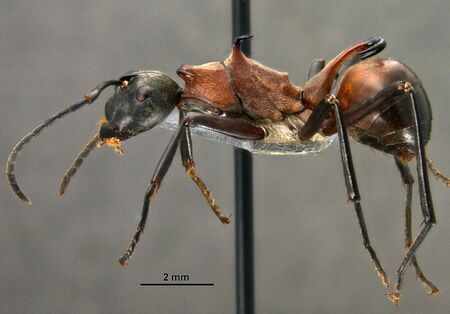Polyrhachis lacroixi
| Polyrhachis lacroixi | |
|---|---|
| Scientific classification | |
| Kingdom: | Animalia |
| Phylum: | Arthropoda |
| Class: | Insecta |
| Order: | Hymenoptera |
| Family: | Formicidae |
| Subfamily: | Formicinae |
| Tribe: | Camponotini |
| Genus: | Polyrhachis |
| Subgenus: | Polyrhachis |
| Species group: | bihamata |
| Species: | P. lacroixi |
| Binomial name | |
| Polyrhachis lacroixi Zettel, 2019 | |
This rare species is known from two collections made in Malaysia. Nothing is known concerning its biology.
Photo Gallery
Identification
Size small, body length ca. 8.5–9.4 mm, head width 1.86–2.02 mm. Bicoloured: head, appendages, tips of spines and posterior part of gaster black; mesosoma, petiole and gaster tergite 1 predominantly reddish. Short pubescence variably dense, sparse on gaster. Standing setae lacking on head (except on clypeus), mesosoma, petiole, and gaster tergites 1–2. Surface mostly matt, shiny on clypeus and gaster. Eyes in full-face view more or less surpassing outline of head. Dorsum of propodeum laterally rounded, posteriorly with a small medial tubercle, without spines or teeth; spiracles strongly elevated. Petiole columnar; petiolar spines hooked, parallel for most of length. Gaster tergites 1–4 with dispersed large shallow punctures.
Polyrhachis lacroixi belongs to the P. bihamata species group as defined by Hung (1970) and Kohout (2014). Within this group, the shiny gaster tergites of P. lacroixi – conspicuous to the naked eye – are an important character and otherwise only present in Polyrhachis tonsilis. The tergites bear rather large, dispersed punctures (not present in P. tonsilis) and their reticulated microsculpture is fine and weakly impressed. Strongly shiny tergites are also present in both species of the P. lamellidens group, but their workers differ, among other characters, by a pair of elongated spines on the propodeum. The second important character of P. lacroixi workers is the strong reduction of propodeal structures to a single, low medial tubercle between its dorsal and declivitous face. It differs clearly from Polyrhachis olybria, a similarly small species with distinct paired teeth at the same position. Further, workers of P. lacroixi possess a median ocellus, that is usually lacking in P. olybria. In details of the spines, P. lacroixi is similar to the sympatric P. bihamata. This species, however, differs by rich standing pilosity, a matt, densely sculptured gaster, and a pair of more laterally positioned ridges at the base of the propodeal declivity.
Keys including this Species
Distribution
Latitudinal Distribution Pattern
Latitudinal Range: 5.37° to 4.42°.
| North Temperate |
North Subtropical |
Tropical | South Subtropical |
South Temperate |
- Source: Zettel, 2019
Distribution based on Regional Taxon Lists
Indo-Australian Region: Malaysia (type locality).
Distribution based on AntMaps
Distribution based on AntWeb specimens
Check data from AntWeb
Countries Occupied
| Number of countries occupied by this species based on AntWiki Regional Taxon Lists. In general, fewer countries occupied indicates a narrower range, while more countries indicates a more widespread species. |

|
Estimated Abundance
| Relative abundance based on number of AntMaps records per species (this species within the purple bar). Fewer records (to the left) indicates a less abundant/encountered species while more records (to the right) indicates more abundant/encountered species. |

|
Biology
Castes
Nomenclature
The following information is derived from Barry Bolton's Online Catalogue of the Ants of the World.
- lacroixi. Polyrhachis (Polyrhachis) lacroixi Zettel, 2019: 62, figs. 4-6 (w.) MALAYSIA.
Type Material
- Holotype worker, Malaysia, Perak, 40 km southeast of Ipoh, Banjaran Titi Wangea, Ringlet, N 4°25', E 101°23', 900 m a.s.l., 3.IV., leg. P. Cechovský, in the Natural History Museum Vienna.
- Paratype, 1 worker, same data as holotype, in the Natural History Museum Vienna.
- Paratype, 1 worker, Malaysia, Kelantan, 10 km west of Dabong, Jelawan Jungle, N 5°22', E 101°52', 150–350 m a.s.l., leg. S. Bečvář, in the author’s collection, Vienna, Austria.

